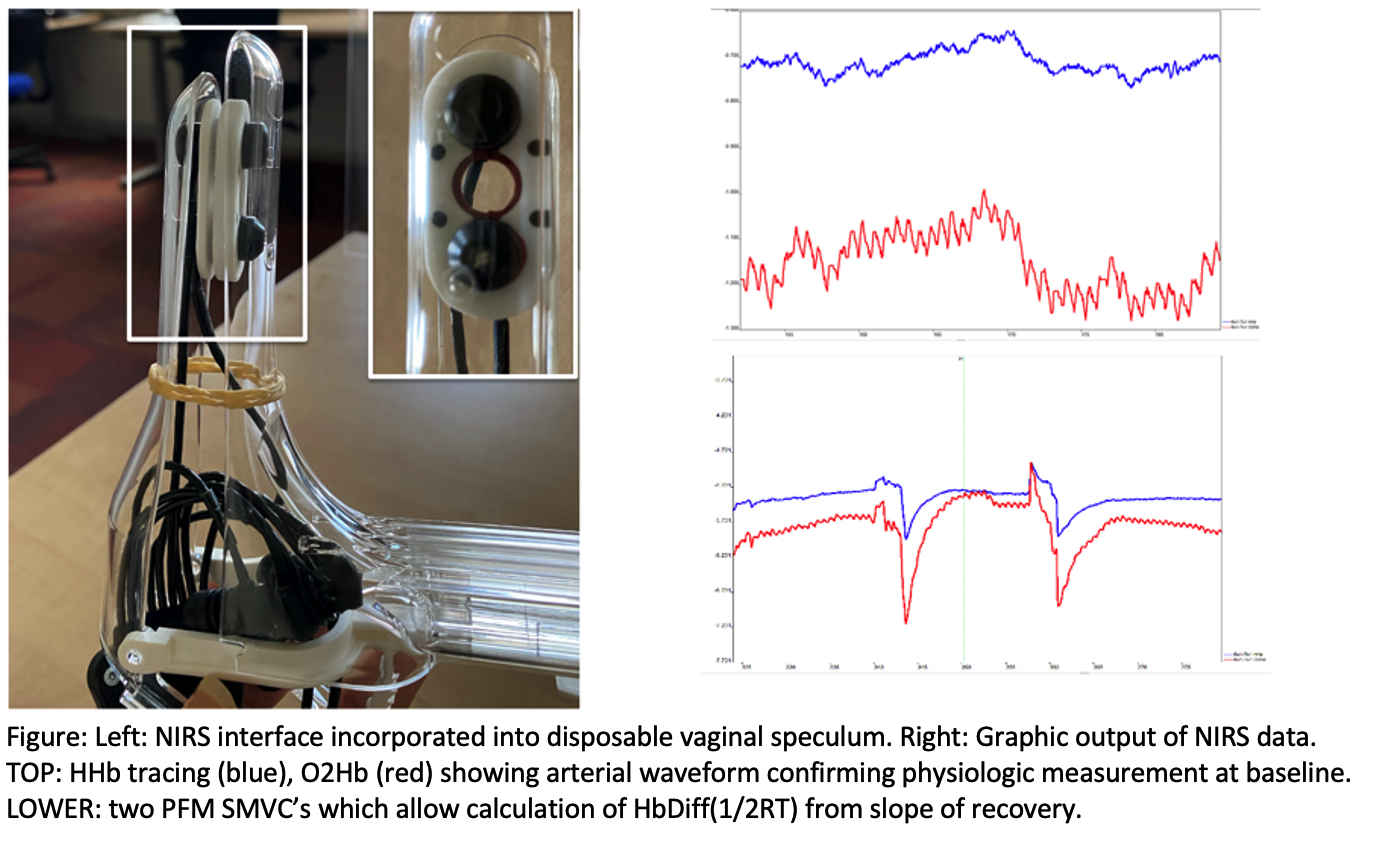Back
Poster, Podium & Video Sessions
Podium
PD24: Urodynamics/Lower Urinary Tract Dysfunction/Female Pelvic Medicine: Neurogenic Voiding Dysfunction
PD24-04: Detection of Pelvic Floor Muscle Activity and Quantification of Oxygen Kinetics in Women With Spinal Cord Injury and Neurogenic Lower Urinary Tract Dysfunction
Saturday, May 14, 2022
10:00 AM – 10:10 AM
Location: Room 245
Lynn stothers*, Andrew Macnab, vancouver, Canada
- LS
Lynn Stothers, MD
University of California Los Angeles
Podium Presenter(s)
Introduction: Paralysis and changes in sensation following spinal cord injury (SCI) are a significant barrier to the performance and quantification of pelvic floor muscle (PFM) exercise in women, although international guidelines recommend PFM therapy.
Aims: (1) to translate for use in PFM evaluation, a validated optical measure of oxygen kinetics used in sports medicine which uses near infrared (NIR) spectroscopy to quantify the half recovery time of reoxygenation (HbDiff(½RT)) following sustained maximal voluntary muscle contraction (SMVC), and (2) design and test a vaginal interface incorporating NIRS technology specific to the needs of women with compromised PFM function due to SCI.
Methods: The vaginal interface (fig left) incorporates 4 NIRS emitter detector arrays; photons of NIR light (wavelengths 825, 950, 1000 nm) monitor changes in oxygenated and deoxygenated hemoglobin (O2Hb/HHb) at capture rates of 10 Hz during PFM muscle contractions. The study protocol included clinical assessment, bladder diary and Qualiveen symptom scores and perineometry, plus changes in O2Hb/HHb at rest and during PFM rehabilitation exercises. The absolute measure HbDiff(½RT) is derived from the slope of reoxygenation following release of each SMVC.
Results: N = 15 women aged 25-59 yrs (5 controls, 10 SCI ASIA B, C, D) completed 4 weeks of PFMT; HbDiff(½RT) data sets were compared within individuals and between clinical groups. Repeatability of patterns of recovery were demonstrable within individuals (fig right).
Conclusions: HbDiff(½RT) is a quantifiable absolute measure of skeletal muscle oxygen kinetics; use of the vaginal interface allows individual elements of the PFM to be evaluated; the ability to quantify right and left sided function independently is particularly relevant in women with PFM dysfunction due to partial SCI. Translation of measurement of HbDiff(½RT) to the PFM now allows a validated muscle reoxygenation parameter to be applied in evaluation of PFM dysfunction following SCI in women, and offers a means to quantify clinical training effects from rehabilitation exercise in NLUTD.
Source of Funding: Craig Neilsen Foundation

Aims: (1) to translate for use in PFM evaluation, a validated optical measure of oxygen kinetics used in sports medicine which uses near infrared (NIR) spectroscopy to quantify the half recovery time of reoxygenation (HbDiff(½RT)) following sustained maximal voluntary muscle contraction (SMVC), and (2) design and test a vaginal interface incorporating NIRS technology specific to the needs of women with compromised PFM function due to SCI.
Methods: The vaginal interface (fig left) incorporates 4 NIRS emitter detector arrays; photons of NIR light (wavelengths 825, 950, 1000 nm) monitor changes in oxygenated and deoxygenated hemoglobin (O2Hb/HHb) at capture rates of 10 Hz during PFM muscle contractions. The study protocol included clinical assessment, bladder diary and Qualiveen symptom scores and perineometry, plus changes in O2Hb/HHb at rest and during PFM rehabilitation exercises. The absolute measure HbDiff(½RT) is derived from the slope of reoxygenation following release of each SMVC.
Results: N = 15 women aged 25-59 yrs (5 controls, 10 SCI ASIA B, C, D) completed 4 weeks of PFMT; HbDiff(½RT) data sets were compared within individuals and between clinical groups. Repeatability of patterns of recovery were demonstrable within individuals (fig right).
Conclusions: HbDiff(½RT) is a quantifiable absolute measure of skeletal muscle oxygen kinetics; use of the vaginal interface allows individual elements of the PFM to be evaluated; the ability to quantify right and left sided function independently is particularly relevant in women with PFM dysfunction due to partial SCI. Translation of measurement of HbDiff(½RT) to the PFM now allows a validated muscle reoxygenation parameter to be applied in evaluation of PFM dysfunction following SCI in women, and offers a means to quantify clinical training effects from rehabilitation exercise in NLUTD.
Source of Funding: Craig Neilsen Foundation


.jpg)
.jpg)